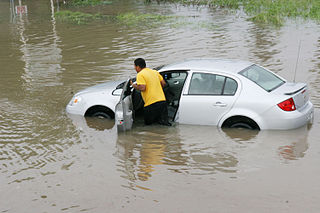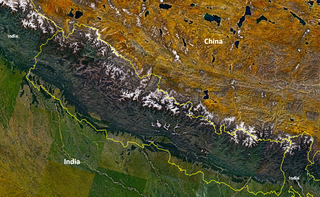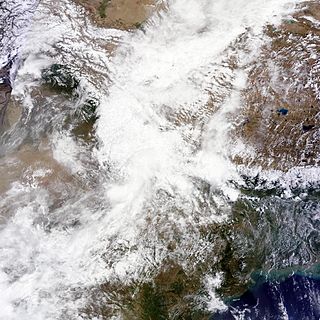| Date | July 12, 2024 |
|---|---|
| Time | c. 3:30 a.m. (NST) |
| Location | Chitwan District, Nepal |
| Cause | Mountain landslide triggered by monsoon rains |
| Deaths | 19+ |
| Non-fatal injuries | 3 |
| Missing | 40 |
The Madan Ashrit Highway disaster was a road accident on July 12, 2024 that was caused by a large landslide that pushed two buses carrying a total of 65 passengers on the Madan Ashrit Highway into the Trishuli River in Nepal. [1] The disaster left at least 19 people dead, [2] injured three people and left 40 others missing. [3]
The monsoon season in Nepal causes significant rainfall to fall from June to September annually, causing mountainous landslides and increased river water levels. Landslides in Nepal during the 24-hour period prior to the accident killed seventeen people. [3]
The Madan Ashrit Highway or NH44 is the busiest international roadway link in Nepal. It carries roughly 20,000 vehicles daily, accounting for about 90% of international traffic. [4] One of the buses was driving roughly 41 passengers from Nepalese capital Kathmandu to Guar, and was operated by Ganapati Deluxe. The second bus was driving roughly 24 passengers from Birgunj to Kathmandu, and was operated by Angel Deluxe. The Angel Deluxe bus was carrying seven Indian nationals. [1]
At around 3:30 am local time, a large landslide struck the two buses as they were driving on the Narayanghat-Mugling road section in the Chitwan district, pushing them into the flooded Trishuli River at least 100 feet from the road which swept the buses downstream. [5] [6] The buses were pushed through concrete barriers before rolling down a steep embankment next to the river. [6] Three passengers on the Ganapati Deluxe bus were able to jump out of the vehicle and swim to stable ground before locals took them to a hospital for treatment. [1] [3]
One victim was recovered about 50 km (31 miles) downstream of the landslide. [7] By 18 July, at least 19 bodies had been recovered, including one that was recovered 100 kilometers away near the border with India. At least seven of the fatalities were identified as Indian nationals. [8] [2]
A third bus was struck by a different landslide on a nearby section of the same highway, killing the driver with further details on casualties currently unknown. [3]
Prime Minister of Nepal Pushpa Kamal Dahal issued rescue directives to all governmental agencies and mobilized over 500 rescue personnel to the site of the accident to search for survivors, including members of the Armed Police Force and a Nepali Army diving team. [1] [3] Rescue efforts were delayed by persistently heavy rainfall and high Trishuli River water levels, as well as by widespread debris caused by other landslides in the region. One-way traffic was reopened after debris was cleared from the highway. [1]
Rescuers were unable to find traces of debris from the buses or any additional survivors by late morning, in part due to heavy rainfall and fast mountainous river flow turning its waters more opaque. The Nepalese government issued a ban on nighttime road travel by passenger buses in regions where weather alerts were issued. [3] Rescue workers were forced to temporarily cease rescue operations in the evening due to the darkness further complicating search efforts. [6]
On 13 July, rescue workers recovered the first victim, prompting them to open up the search area to the southern location of where the victim was found. [7]

Nepal Ratna Man Padavi Madan Kumar Bhandari, commonly known as Madan Bhandari, was a popular Nepali political leader belonging to the Communist Party of Nepal, a democratic communist party in Nepal. He defeated the incumbent Prime Minister Krishna Prasad Bhattarai in a landslide victory in the 1991 general election. Known for his charismatic style, Bhandari propounded the popular communist principle or thought "People's Multiparty Democracy". He is widely regarded for peaking the Nepal's communist movement to a greater height. He died in a jeep accident in Dasdhunga, Chitwan, in 1993.

The "stupid motorist law" is a law in the U.S. state of Arizona that states that any motorist who becomes stranded after driving around barricades to enter a flooded stretch of roadway may be charged for the cost of their rescue. The law corresponds to section 28-910 of the Arizona Revised Statutes.
Bidur is the capital of Nuwakot District in Bagmati Province, Nepal. At the time of the 1991 Nepal census it had a population of 18694 and had 3736 houses in it.

The Araniko Highway or NH 3(Nepali: अरनिको राजमार्ग, Araniko Rajmarga) connects Kathmandu with Kodari, 112 kilometres (70 mi) northeast of the Kathmandu Valley, on the Nepal-China border. It is among the most dangerous of highways in Nepal due to extremely steep slopes on each side of the road from Barabise onwards; massive landslides and bus plunges are not uncommon, especially after rains. At the Sino-Nepal Friendship Bridge, it connects with China National Highway 318 to Lhasa, and eventually to Shanghai.

The Trishuli River is one of the major tributaries of the Narayani River basin in central Nepal. The river is formed by the merger of the Kyirong Tsangpo and the Lende Khola originating in Gyirong County of Tibet, which join together near the Rasuwa Gadhi on the Nepal–Tibet border. The valley of the river used to be the traditional trade route between the Kathmandu Valley and Tibet.

Nepal Transport Service was the first, and for a time, the largest, Nepalese public bus line. The company was based in the capital Kathmandu and operated from 1959 to 1966. Its head office was located at 122 Asan Tyouda Tol, Kathmandu.

Nepal was hit by serious flooding in May 2012.

In June 2013, a mid-day cloudburst centered on the North Indian state of Uttarakhand caused devastating floods and landslides, becoming the country's worst natural disaster since the 2004 tsunami. The rainfall received that month was far greater than the rainfall the state usually received. Debris blocked the rivers, causing major overflow. The main day of the flood was 16 June 2013.
Operation Maitri was a rescue and relief operation in Nepal by the government of India and Indian armed forces in the aftermath of the April 2015 Nepal earthquake. Indian government responded within few minutes of the quake. It started on 26 April 2015 and also involved Nepali ex-servicemen from India's Gurkha Regiments for interface for guidance, relief and rescue.
On 15 August 2016, two separate bus crashes in Nepal led to the deaths of several people; dozens more were injured. There was speculation in the aftermath of the accidents, that miscommunication regarding the availability of government grants may have led to overcrowding on one of the buses. Days of rainfall preceded the accidents.
In June 2021, the flood in Melamchi River caused damage in the Melamchi Bazar in Sindhupalchowk District of Nepal killing several locals and some foreigners

Mugling is a town in Chitwan, Bagmati Province, Nepal.

Tara Air Flight 197 was a scheduled domestic flight operated by Tara Air for parent company Yeti Airlines from Pokhara Airport to Jomsom Airport in Nepal. On 29 May 2022, the Twin Otter aircraft carrying 22 people departed at 09:55 NPT and lost contact with air traffic controllers about 12 minutes later at 10:07 (04:22). The wreckage was located 20 hours later on a mountainside. All 22 passengers and crew were killed, and all 22 bodies were recovered. This was Tara Air's second deadly accident on this route, after Flight 193 in 2016.
Events in the year 2024 in Nepal.

On 16 June 2024, a landslide made out of mud and debris struck a highway in the resort city of Baños, Tungurahua in Ecuador following heavy rainfall, striking at least three cars, two houses and a bus, and killing at least eight people with over 11 people missing.
The 2024 Sulawesi landslide was a mass casualty event that occurred at an unauthorized gold mine in the Bone Bolango regency located in Gorontalo province on the island of Sulawesi, Indonesia, on 6 July 2024. The disaster occurred as a result of heavy rainfall causing a landslide that struck over 100 villagers digging for gold at the site of the gold mine, killing at least twelve people and leaving about 48 more missing.
On 16 July 2024, at approximately 08:30 IST, a landslide occurred in Shirur, Ankola in Uttara Kannada in the Indian state of Karnataka. The landslide was caused by construction work and heavy rains, and resulted in at least nine deaths, with two missing in the debris or nearby Gangavali River.
Torrential rainfall during the annual monsoon season in early July, mid August, and late September 2024 caused massive flooding across Nepal as well as several mudslides. The September floods, which caused the most damage and deaths, were caused by the heaviest rainfall recorded in the region since at least 1970, the result of a low-pressure system. The impact of the floods was further increased by poor infrastructure and settlement planning, including unplanned construction on floodplains.
On 28 November 2024, heavy rainfall caused a series of landslides to strike six villages in the Bulambuli District, located in mountainous regions of eastern Uganda. The damage caused by the landslides caused the deaths of at least 20 people, with 113 reported by Ugandan police as missing.